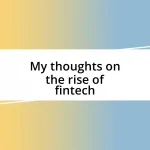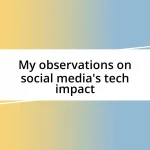Key takeaways:
- Networking at conferences creates deeper, meaningful connections that can lead to collaborations and opportunities beyond the event.
- Keynote speeches and panel discussions inspire attendees and challenge existing beliefs, fostering a sense of community and prompting actionable insights.
- Following up after conferences with timely messages, action plans, and shared reflections can enhance relationships and translate knowledge into real-world applications.

What to expect from conferences
When attending a tech industry conference, you can expect a whirlwind of knowledge exchange and networking opportunities. I still remember my first conference—it felt like stepping into a vibrant marketplace of ideas, where every conversation could lead to a breakthrough. Have you ever felt overwhelmed by so much innovation in one place?
Workshops and keynote speeches often take center stage, offering insights from industry leaders that can shift your perspective completely. I once left a session on AI ethics not only inspired but questioning how I could apply those ideas locally. Isn’t it fascinating how a single talk can ripple through your entire approach to work?
Networking can be an emotional rollercoaster. There’s that initial anxiety of approaching strangers, but I find that once you break the ice, those moments can blossom into lasting connections. Have you ever experienced the rush of exchanging contact info with someone you admire in the industry? It’s these interactions that often lead to exciting collaborations or opportunities down the line.

Importance of networking at conferences
Networking at conferences is truly a game changer. I recall attending a panel discussion about emerging technologies and sitting next to a startup founder who shared his journey. That chance encounter led to a working relationship that opened avenues I hadn’t considered before. It struck me how powerful that spontaneous conversation was—far more impactful than any brochure or website could convey.
Building relationships in-person often carries a weight that online networking just can’t match. I’ve had moments at conferences where a handshake or shared laugh transformed a simple introduction into a meaningful connection. These dynamics create a fertile ground for collaboration, allowing us to exchange ideas in a way that feels more authentic and engaging. Have you ever left a conversation with a new contact feeling energized and inspired?
It’s also valuable to remember that these networks extend beyond the event itself. After one conference, I initiated a small group with a few connections I made there. Our monthly video calls became a hub for sharing resources and tackling industry challenges together. This experience has shown me that the conference isn’t just about those few days; it’s about nurturing the relationships that can flourish long after the event.
| In-Person Networking | Online Networking |
|---|---|
| Fosters deeper connections | More convenient but may lack depth |
| Opportunities for spontaneous conversations | Limited to pre-planned interactions |
| Creates lasting memories and contacts | Contacts can feel more transient |

Keynote speeches and their impact
Keynote speeches at tech industry conferences have a profound impact on attendees, often shaping their professional landscapes. I still remember one session at a pivotal conference where a renowned speaker shared her journey in overcoming challenges. The emotions in the room were palpable; I could see people nodding in agreement, as her words resonated deeply with many of us. This is the kind of experience that underscores the true power of a well-delivered keynote.
- Engages and inspires attendees through personal stories
- Challenges existing beliefs and prompts new ways of thinking
- Fosters a sense of community among listeners, often leading to discussions
- Offers industry insights that are often not available elsewhere
- Leaves attendees feeling motivated to implement learned ideas in their own work
Another instance that stands out to me was a talk on the future of cybersecurity. The speaker didn’t just list trends but painted a vivid picture of potential implications for our everyday lives. It hit me hard, sparking a flurry of questions I began to ask myself. His passionate delivery made each point stick; I found myself writing notes feverishly. Moments like these demonstrate how keynote speeches can ignite a fire within us, prompting reflection and action long after we leave the conference hall.
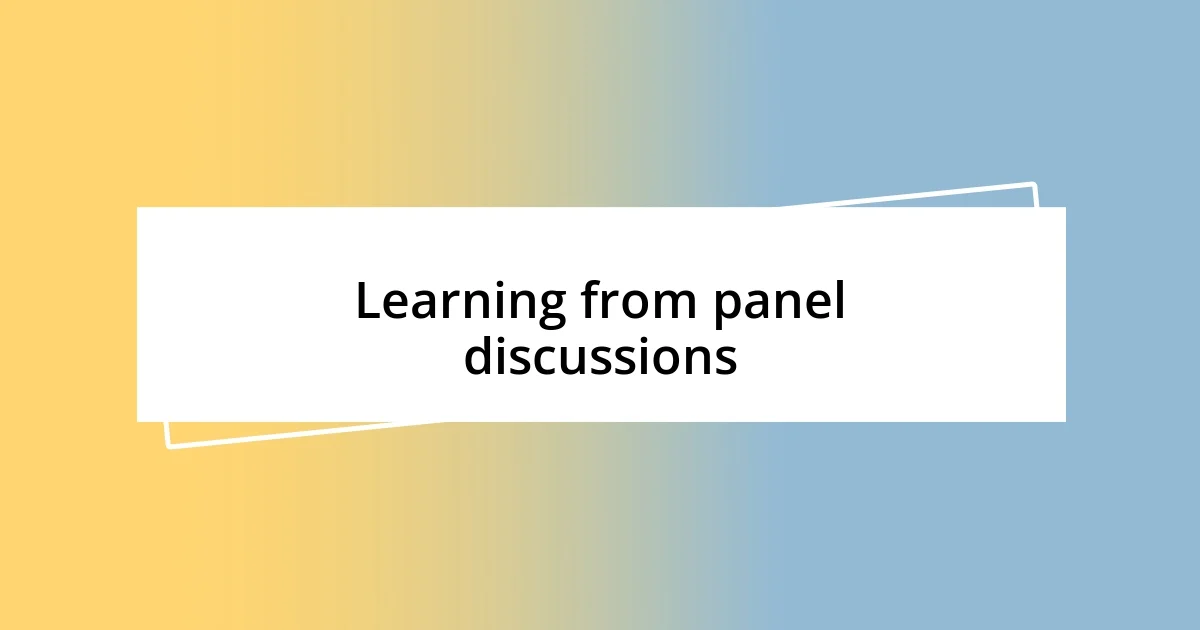
Learning from panel discussions
Engaging with panel discussions at conferences has always been a highlight for me. I recall a particularly thought-provoking panel on artificial intelligence where experts from different sectors weighed in on the ethical implications of technology. Listening to them articulate their diverse viewpoints not only deepened my understanding but also made me question my own beliefs about the industry. Have you ever left a session feeling a sense of urgency to reevaluate your stance? Those moments are often transformative.
One key takeaway from panel discussions is the opportunity to experience real-time debates and dialogues. I remember when a heated question about data privacy sparked a lively exchange among the panelists, revealing a spectrum of opinions. The electricity in the room was palpable; it was as if we were all part of a shared exploration of ideas. This dynamic environment often leads to insights you can’t find in textbooks or articles. It’s where I’ve learned that differing perspectives can challenge me to think critically and approach problems from angles I hadn’t considered.
What’s fascinating is how panel discussions can catalyze collective problem-solving. After one such discussion about the future of remote work, I connected with fellow attendees who were grappling with similar challenges. That led to an impromptu brainstorming session right in the conference lounge, where we exchanged strategies and solutions. The beauty of these interactions lies in their spontaneity; they can turn into meaningful collaborations that extend well beyond the event. How many times have you walked away feeling not just informed but inspired to take action?
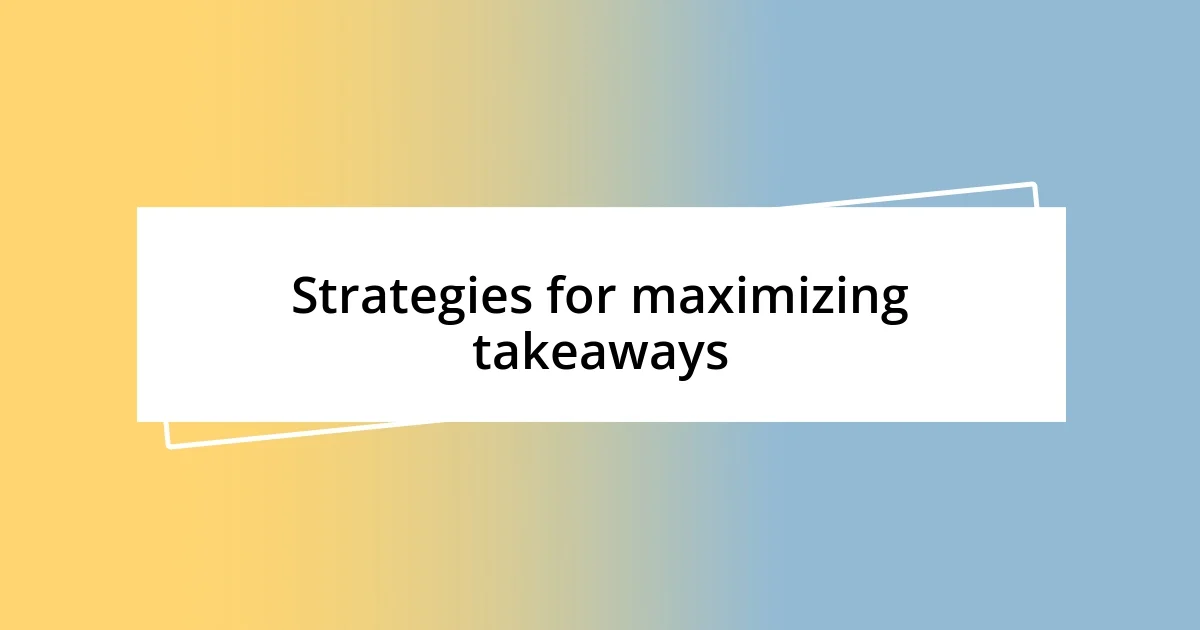
Strategies for maximizing takeaways
Taking full advantage of a tech conference means being strategic about your approach. For instance, I’ve learned that preparing a set of specific questions before each session can drive deeper engagement with speakers. When I first tried this method, I found myself not only asking questions, but building connections that turned into fruitful discussions afterward. Have you ever left a session wishing you’d asked something more? That preparation can make all the difference.
Another strategy is to actively participate in workshops and hands-on sessions. I remember attending a coding workshop where the instructor encouraged us to collaborate in small groups. As we tackled problems together, I felt an adrenaline rush; the energy was infectious. That experience not only solidified my understanding of the material but also allowed me to form friendships with fellow tech enthusiasts. The value of hands-on learning and collaboration can’t be overstated—it’s where theory transforms into tangible skills.
It’s also crucial to take time for reflection after each day. In the past, I would rush to network or attend after-parties, but now I carve out moments to jot down my insights. This practice has transformed my experience considerably, as I revisit those notes to connect the dots later on. Have you tried this method? Capturing those immediate thoughts can be vital for reinforcing what you’ve learned and strategizing how to apply it going forward.
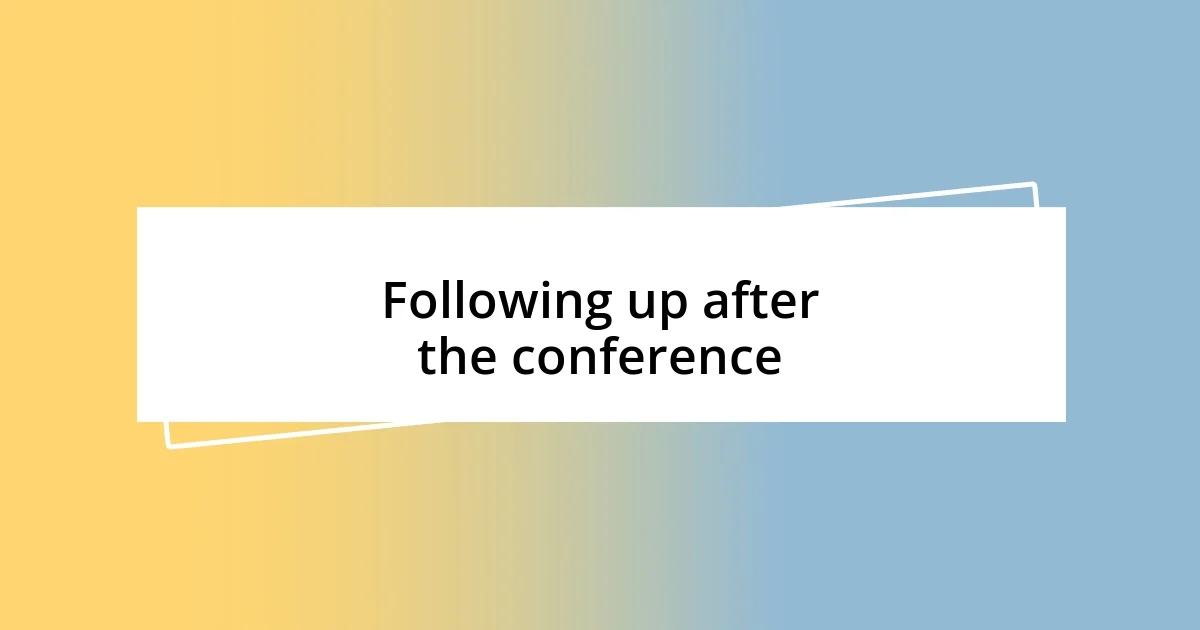
Following up after the conference
Following up after a conference can be a game-changer, and I’ve learned that timing is everything. I usually try to send a quick thank-you email or message to speakers and new connections within a few days of the event. I remember reaching out to a panelist who shared invaluable industry insights on cloud technology. Her response not only reinforced my understanding but also sparked a conversation that led to ongoing exchanges and potential collaboration. Have you considered how those simple follow-ups can open doors to new relationships?
I’ve also found creating a post-conference action plan incredibly helpful. After attending a session on innovative cybersecurity practices, I took the initiative to implement some strategies in my workplace. I not only shared my learning with my team but organized a brainstorming session to explore how we could adapt these ideas. It was exciting to see my colleagues get enthused and contribute their perspectives. When was the last time you translated conference knowledge into real-world applications?
Documenting key insights and sharing them with peers is another follow-up strategy I’ve embraced. I started a blog where I summarize my experiences and discuss ideas from the conferences I attend. Writing this not only helps me reflect deeply but also encourages discussions with others who read it. The feedback has been invaluable, turning initial thoughts into a community dialogue. Have you ever thought about how sharing your insights could enrich others’ learning experiences too?








